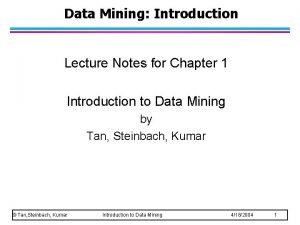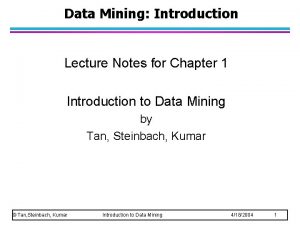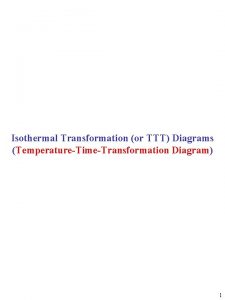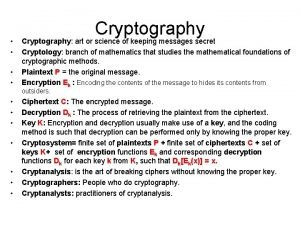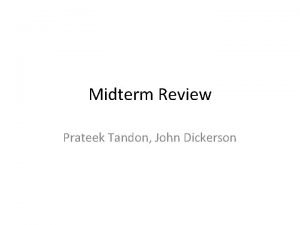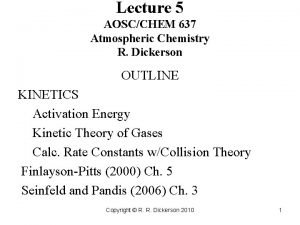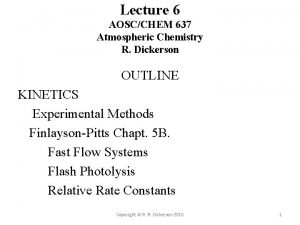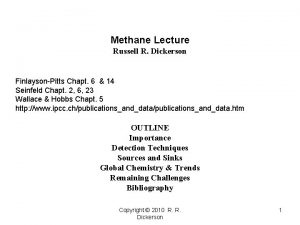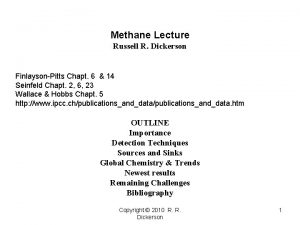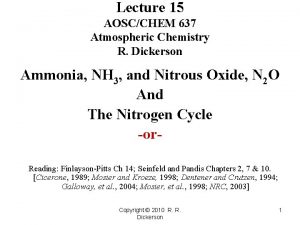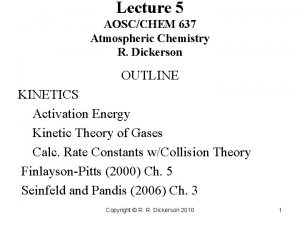INTRODUCTION TO DATA SCIENCE JOHN P DICKERSON Lecture







































- Slides: 39

INTRODUCTION TO DATA SCIENCE JOHN P DICKERSON Lecture #3 – 09/03/2019 CMSC 320 Tuesdays & Thursdays 5: 00 pm – 6: 15 pm

ANNOUNCEMENTS Register on Piazza: piazza. com/umd/fall 2019/cmsc 320 • 267 have registered already • 31 have not registered yet If you were on Piazza, you’d know … • Project 0 is out! It is “due” this Wednesday evening. • Link: https: //github. com/cmsc 320/fall 2019/tree/master/project 0 We’ve also linked some reading for the week! 2 • First quiz is due Thursday at noon; on ELMS now.

ANNOUNCEMENTS Office hours are posted on the course webpage: • https: //cmsc 320. github. io/ • Subject to change; I will update the course webpage if so! Office hours are held in AVW 1120. (AVW? ! Yuck. ) We have coverage before noon and after noon for every weekday (MTWTh. F). 3 • TAs will also “cover” Piazza for the working hours of the day on which they are holding office hours.

THE DATA LIFECYCLE Data processing Analysis, hypothesis testing, & ML Insight & Policy Decision 4 Data collection Exploratory analysis & Data viz

TODAY’S LECTURE Data processing Analysis, hypothesis testing, & ML Insight & Policy Decision … on to the “collection” part of things … 5 Data collection Exploratory analysis & Data viz

GOTTA CATCH ‘EM ALL Five ways to get data: • Direct download and load from local storage • Generate locally via downloaded code (e. g. , simulation) • Query data from a database (covered in a few lectures) • Scrape data from a webpage Covered today. 6 • Query an API from the intra/internet

WHEREFORE ART THOU, API? A web-based Application Programming Interface (API) like we’ll be using in this class is a contract between a server and a user stating: “If you send me a specific request, I will return some information in a structured and documented format. ” 7 (More generally, APIs can also perform actions, may not be web-based, be a set of protocols for communicating between processes, between an application and an OS, etc. )

“SEND ME A SPECIFIC REQUEST” Most web API queries we’ll be doing will use HTTP requests: • conda install –c anaconda requests=2. 12. 4 r = requests. get( 'https: //api. github. com/user', auth=('user', 'pass') ) r. status_code 200 r. headers[‘content-type’] ‘application/json; charset=utf 8’ {u'private_gists': 419, u'total_private_repos': 77, . . . } http: //docs. python-requests. org/en/master/ 8 r. json()

HTTP REQUESTS https: //www. google. com/? q=cmsc 320&tbs=qdr: m ? ? ? ? ? HTTP GET Request: GET /? q=cmsc 320&tbs=qdr: m HTTP/1. 1 Host: www. google. com User-Agent: Mozilla/5. 0 (X 11; Linux x 86_64; rv: 10. 0. 1) Gecko/20100101 Firefox/10. 0. 1 params = { “q”: “cmsc 320”, “tbs”: “qdr: m” } r = requests. get( “https: //www. google. com”, params = params ) 9 *be careful with https: // calls; requests will not verify SSL by default

RESTFUL APIS This class will just query web APIs, but full web APIs typically allow more. Representational State Transfer (RESTful) APIs: • GET: perform query, return data • POST: create a new entry or object • PUT: update an existing entry or object • DELETE: delete an existing entry or object 10 Can be more intricate, but verbs (“put”) align with actions

QUERYING A RESTFUL API Stateless: with every request, you send along a token/authentication of who you are token = ”super_secret_token” r = requests. get(“https: //github. com/user”, params={”access_token”: token}) print( r. content ) {"login": ”John. Dickerson", "id": 472985, "avatar_url": "ht… Git. Hub is more than a GETHub: • PUT/POST/DELETE can edit your repositories, etc. 11 • Try it out: https: //github. com/settings/tokens/new

AUTHENTICATION AND OAUTH Old and busted: r = requests. get(“https: //api. github. com/user”, auth=(“John. Dickerson”, “ILove. Kittens”)) New hotness: • What if I wanted to grant an app access to, e. g. , my Facebook account without giving that app my password? 12 • OAuth: grants access tokens that give (possibly incomplete) access to a user or app without exposing a password

“… I WILL RETURN INFORMATION IN A STRUCTURED FORMAT. ” So we’ve queried a server using a well-formed GET request via the requests Python module. What comes back? General structured data: • Comma-Separated Value (CSV) files & strings • Javascript Object Notation (JSON) files & strings • HTML, XML files & strings Domain-specific structured data: • Shapefiles: geospatial vector data (Open. Street. Map) • RVT files: architectural planning (Autodesk Revit) 13 • You can make up your own! Always document it.

GRAPHQL? An alternative to REST and ad-hoc webservice architectures https: //dev-blog. apollodata. com/graphql-vs-rest-5 d 425123 e 34 b 14 • Developed internally by Facebook and released publicly Unlike REST, the requester specifies the format of the response

CSV FILES IN PYTHON Any CSV reader worth anything can parse files with any delimiter, not just a comma (e. g. , “TSV” for tab-separated) 1, 26 -Jan, Introduction, —, "pdf, pptx", Dickerson, 2, 31 -Jan, Scraping Data with Python, Anaconda's Test Drive. , , Dickerson, 3, 2 -Feb, "Vectors, Matrices, and Dataframes", Introduction to pandas. , , Dickerson, 4, 7 -Feb, Jupyter notebook lab, , , "Denis, Anant, & Neil", 5, 9 -Feb, Best Practices for Data Science Projects, , , Dickerson, Don’t write your own CSV or JSON parser (We’ll use pandas to do this much more easily and efficiently) 15 import csv with open(“schedule. csv”, ”rb”) as f: reader = csv. reader(f, delimiter=“, ”, quotechar=’”’) for row in reader: print(row)

JSON FILES & STRINGS JSON is a method for serializing objects: • Convert an object into a string (done in Java in 131/132? ) • Deserialization converts a string back to an object Easy for humans to read (and sanity check, edit) Defined by three universal data structures Python dictionary, Java Map, hash table, etc … Python string, float, int, boolean, JSON object, JSON array, … Images from: http: //www. json. org/ 16 Python list, Java array, vector, etc …

JSON IN PYTHON Some built-in types: “Strings”, 1. 0, True, False, None Lists: [“Goodbye”, “Cruel”, “World”] Dictionaries: {“hello”: “bonjour”, “goodbye”, “au revoir”} Dictionaries within lists within dictionaries within lists: [1, 2, {“Help”: [ 17 “I’m”, {“trapped”: “in”}, “CMSC 320” ]}]

JSON FROM TWITTER GET https: //api. twitter. com/1. 1/friends/list. json? cursor=1&screen_name=twitterapi&skip_status=true&include_user_entities=false { 18 "previous_cursor": 0, "previous_cursor_str": "0", "next_cursor": 1333504313713126852, "users": [{ "profile_sidebar_fill_color": "252429", "profile_sidebar_border_color": "181 A 1 E", "profile_background_tile": false, "name": "Sylvain Carle", "profile_image_url": "http: //a 0. twimg. com/profile_images/2838630046/4 b 82 e 286 a 659 fae 310012520 f 4 f 7 56 bb_normal. png", "created_at": "Thu Jan 18 00: 10: 45 +0000 2007", …

PARSING JSON IN PYTHON Repeat: don’t write your own CSV or JSON parser • https: //news. ycombinator. com/item? id=7796268 • rsdy. github. io/posts/dont_write_your_json_parser_plz. html Python comes with a fine JSON parser import json r = requests. get( “https: //api. twitter. com/1. 1/statuses/user_timeline. json? screen_name=John PDickerson&count=100”, auth=auth ) json. load(some_file) # loads JSON from a file json. dump(json_obj, some_file) # writes JSON to file json. dumps(json_obj) # returns JSON string 19 data = json. loads(r. content)

XML, XHTML, HTML FILES AND STRINGS Still hugely popular online, but JSON has essentially replaced XML for: • Asynchronous browser server calls • Many (most? ) newer web APIs XML is a hierarchical markup language: <tag attribute=“value 1”> <subtag> Some content goes here </subtag> <openclosetag attribute=“value 2” /> </tag> Example XML from: Zico Kolter 20 You probably won’t see much XML, but you will see plenty of HTML, its substantially less well-behaved cousin …

DOCUMENT OBJECT MODEL (DOM) XML encodes Document. Object Models (“the DOM”) The DOM is tree-structured. Easy to work with! Everything is encoded via links. 21 Can be huge, & mostly full of stuff you don’t need …

SAX (Simple API for XML) is an alternative “lightweight” way to process XML. A SAX parser generates a stream of events as it parses the XML file. The programmer registers handlers for each one. Example from John Canny 22 It allows a programmer to handle only parts of the data structure.

SCRAPING HTML IN PYTHON HTML – the specification – is fairly pure HTML – what you find on the web – is horrifying We’ll use Beautiful. Soup: • conda install -c asmeurer beautiful-soup=4. 3. 2 import requests from bs 4 import Beautiful. Soup root = Beautiful. Soup( r. content ) root. find(“div”, id=“schedule”). find(“table”) # find all schedule. find(“tbody”). find. All(“a”) # links for CMSC 320 23 r = requests. get( “https: //cs. umd. edu/class/fall 2019/cmsc 320/” )

BUILDING A WEB SCRAPER IN PYTHON Totally not hypothetical situation: • You really want to learn about data science, so you choose to download all of last semester’s CMSC 320 lecture slides to wallpaper your room … • … but you now have carpal tunnel syndrome from clicking refresh on Piazza last night, and can no longer click on the PDF and PPTX links. Hopeless? No! Earlier, you built a scraper to do this! Sort of. You only want PDF and PPTX files, not links to other websites or files. 24 lnks = root. find(“div”, id=“schedule”). find(“table”) # find all schedule. find(“tbody”). find. All(“a”) # links for CMSC 320

REGULAR EXPRESSIONS Given a list of URLs (strings), how do I find only those strings that end in *. pdf or *. pptx? • Regular expressions! • (Actually Python strings come with a built-in endswith function. ) “this_is_a_filename. pdf”. endswith((“. pdf”, “. pptx”)) What about. p. Df or. p. PTx, still legal extensions for PDF/PPTX? • Regular expressions! “t. Hi. S_IS_a_File. NAme. p. DF”. lower(). endswith( (“. pdf”, “. pptx”)) 25 • (Or cheat the system again: built-in string lower function. )

26

REGULAR EXPRESSIONS Used to search for specific elements, or groups of elements, that match a pattern Indispensable for data munging and wrangling Many constructs to search a variety of different patterns Many languages/libraries (including Python) allow “compiling” Much faster for repeated applications of the regex pattern 27 https: //blog. codinghorror. com/to-compile-or-not-to-compile/

REGULAR EXPRESSIONS Used to search for specific elements, or groups of elements, that match a pattern import re # Find the index of the 1 st occurrence of “cmsc 320” match = re. search(r”cmsc 320”, text) print( match. start() ) # Does start of text match “cmsc 320”? match = re. match(r”cmsc 320”, text) # Return all matches of “cmsc 320” in the text match = re. findall(r”cmsc 320”, text) 28 # Iterate over all matches for “cmsc 320” in text for match in re. finditer(r”cmsc 320”, text): print( match. start() )

MATCHING MULTIPLE CHARACTERS Can match sets of characters, or multiple and more elaborate sets and sequences of characters: • Match the character ‘a’: a • Match the character ‘a’, ‘b’, or ‘c’: [abc] • Match any character except ‘a’, ‘b’, or ‘c’: [^abc] • Match any digit: d (= [0123456789] or [0 -9]) • Match any alphanumeric: w (= [a-z. A-Z 0 -9_]) • Match any whitespace: s (= [ tnrfv]) • Match any character: . Thanks to: Zico Kolter 29 Special characters must be escaped: . ^$*+? {}[]|()

MATCHING SEQUENCES AND REPEATED CHARACTERS A few common modifiers (available in Python and most other high-level languages; +, {n}, {n, } may not): • Match character ‘a’ exactly once: a • Match character ‘a’ zero or once: a? • Match character ‘a’ zero or more times: a* • Match character ‘a’ one or more times: a+ • Match character ‘a’ exactly n times: a{n} • Match character ‘a’ at least n times: a{n, } Example: match all instances of “University of <somewhere>” where <somewhere> is an alphanumeric string with at least 3 characters: s*Universitysofsw{3, } 30 •

GROUPS What if we want to know more than just “did we find a match” or “where is the first match” …? Grouping asks the regex matcher to keep track of certain portions – surrounded by (parentheses) – of the match s*([Uu]niversity)s([Oo]f)s(w{3({, regex = r”s*([Uu]niversity)s([Oo]f)s(w{3, })” m = re. search( regex, “university Of Maryland” ) print( m. groups() ) 31 ('university', 'Of', 'Maryland')


NAMED GROUPS Raw grouping is useful for one-off exploratory analysis, but may get confusing with longer regexes • Much scarier regexes than that email one exist in the wild … Named groups let you attach position-independent identifiers to groups in a regex (? P<some_name> …) 'Maryland' 33 regex = "s*[Uu]niversitys[Oo]fs(? P<school>(w{3, }))" m = re. search( regex, “University of Maryland” ) print( m. group(‘school’) )

SUBSTITUTIONS The Python string module contains basic functionality for find-and-replace within strings: ”abcabcabc”. replace(“a”, ”X”) ‘Xbc. Xbc` For more complicated stuff, use regexes: text = “I love Introduction to Data Science” re. sub(r”Data Science”, r”Schmada Schmience”, text) ‘I love Introduction to Schmada Schmience` Can incorporate groups into the matching Thanks to: Zico Kolter 34 re. sub(r”(w+)s([Ss]cience”, r”1 2 hmience”, text)

COMPILED REGEXES If you’re going to reuse the same regex many times, or if you aren’t but things are going slowly for some reason, try compiling the regular expression. • https: //blog. codinghorror. com/to-compile-or-not-to-compile/ # Compile the regular expression “cmsc 320” regex = re. compile(r”cmsc 320”) # Use it repeatedly to search for matches in text regex. match( text ) # does start of text match? regex. search( text ) # find the first match or None regex. findall( text ) # find all matches 35 Interested? CMSC 330, CMSC 452, talk to me.

DOWNLOADING A BUNCH OF FILES Import the modules import requests from bs 4 import Beautiful. Soup try: from urllib. parse import urlparse except Import. Error: from urlparse import urlparse Get some HTML via HTTP # Use Beautiful. Soup to parse the GET response root = Beautiful. Soup( r. content ) lnks = root. find("div", id="schedule"). find("table"). find("tbody"). find. All("a") 36 # HTTP GET request sent to the URL url r = requests. get( url )

DOWNLOADING A BUNCH OF FILES Parse exactly what you want # Cycle through the href for each anchor, checking # to see if it's a PDF/PPTX link or not for lnk in lnks: href = lnk['href'] # If it's a PDF/PPTX link, queue a download if href. lower(). endswith(('. pdf', '. pptx')): Get some more data? ! # Write the downloaded PDF to a file outfile = path. join(outbase, href) with open(outfile, 'wb') as f: f. write(rd. content) 37 urld = urlparse. urljoin(url, href) rd = requests. get(urld, stream=True)

NEXT LECTURE Data processing Analysis, hypothesis testing, & ML Insight & Policy Decision 38 Data collection Exploratory analysis & Data viz

NEXT CLASS: 39 NUMPY, SCIPY, AND DATAFRAMES
 John p dickerson
John p dickerson Cmsc 320 github
Cmsc 320 github Sally dickerson
Sally dickerson Evan dickerson
Evan dickerson 01:640:244 lecture notes - lecture 15: plat, idah, farad
01:640:244 lecture notes - lecture 15: plat, idah, farad Her favourite subject be english
Her favourite subject be english Sciencefusion think central
Sciencefusion think central Physical science lecture notes
Physical science lecture notes Introduction to biochemistry lecture notes
Introduction to biochemistry lecture notes Introduction to psychology lecture
Introduction to psychology lecture Introduction to algorithms lecture notes
Introduction to algorithms lecture notes Exploratory data analysis lecture notes
Exploratory data analysis lecture notes Bayesian classification in data mining lecture notes
Bayesian classification in data mining lecture notes Data mining lecture notes
Data mining lecture notes Data visualization lecture
Data visualization lecture Data mining lecture notes
Data mining lecture notes Data mining lecture notes
Data mining lecture notes Introduction to data warehousing and data mining
Introduction to data warehousing and data mining John jay science and engineering academy
John jay science and engineering academy Social science vs natural science
Social science vs natural science What are the branches of natural science
What are the branches of natural science Natural and physical science
Natural and physical science Applied science vs pure science
Applied science vs pure science Anthropology vs sociology
Anthropology vs sociology Rule of 70 in population growth
Rule of 70 in population growth Windcube lidar
Windcube lidar Soft science definition
Soft science definition Introduction to hospitality marketing
Introduction to hospitality marketing John r walker introduction to hospitality management
John r walker introduction to hospitality management Purpled thy nail
Purpled thy nail Platonic love in john donne poetry
Platonic love in john donne poetry John r walker introduction to hospitality management
John r walker introduction to hospitality management Science investigatory
Science investigatory Introduction to management science chapter 5 solutions
Introduction to management science chapter 5 solutions Erik perjons
Erik perjons Introduction to management science chapter 1 solutions
Introduction to management science chapter 1 solutions History of forensic science ppt
History of forensic science ppt Introduction to materials science for engineers chapter 10
Introduction to materials science for engineers chapter 10 Introduction to behavioral science
Introduction to behavioral science Cryptology an introduction to the art and science
Cryptology an introduction to the art and science















